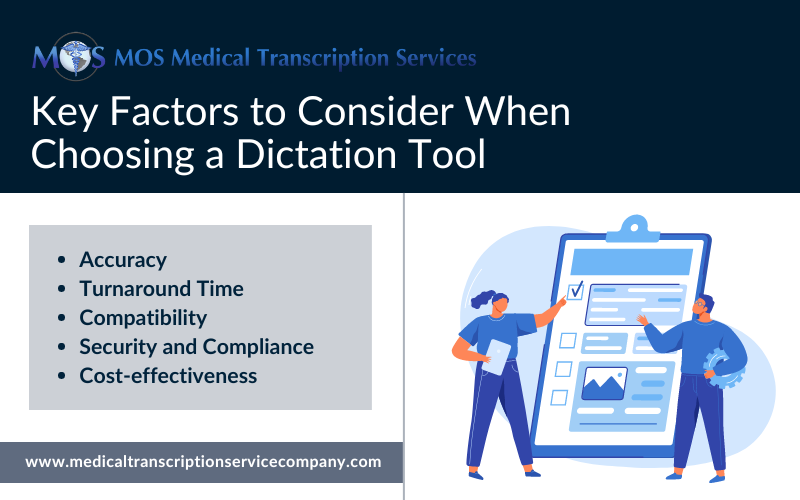
Table of Contents
Medical professionals are constantly seeking efficient ways to streamline their documentation and record-keeping processes. One critical aspect of this is the use of dictation tools to generate medical records, reports, and other necessary documentation. As the demand for accurate and timely medical transcription services continues to grow, it’s essential for healthcare providers to carefully evaluate the various dictation tools available and determine the best fit for their specific needs.
Use of Telephone Dictation
Advantages
One common and established technique in medical transcription services is telephone dictation. By using this technique, medical experts can transcribe their notes over the phone to be edited by a transcriptionist. The ease of use and accessibility of telephone dictation are among its main benefits. Healthcare professionals no longer need specific hardware or software to dictate their notes-they can use any phone. Time is of utmost importance in fast-paced medical contexts, where this ease of use is especially helpful. Additionally, telephone dictation enables continuous, instantaneous dictation, which can improve information flow and lower the possibility of data being overlooked. Since it doesn’t rely on complicated technology or internet access, which could malfunction or have problems, it is also a dependable way.
Drawbacks
But there are disadvantages to telephone dictation as well. Background noise, a weak signal, or inadequate phone lines can all degrade the audio quality, making transcribing more difficult and time-consuming. Furthermore, a lack of visual signals may cause patient details and complicated medical language to be misunderstood or misinterpreted.
Emergence of Speech to Text Software
Advantages
A more modern method of dictation that makes use of advances in machine learning and artificial intelligence is speech-to-text software. These systems provide a rapid and effective technique to create medical records by converting spoken words into text in real time. Well-known speech-to-text programs have large medical vocabularies and the capacity to detect and reliably transcribe technical medical terms; they are specifically made for use in medical settings. Time savings is one of the main advantages of speech-to-text software. Healthcare professionals can quickly check and edit their notes after they are automatically transformed to text thanks to automation of the transcription process. This instantaneity can speed up medical paperwork turnaround and increase efficiency.
Drawbacks
Speech-to-text software has drawbacks in addition to its benefits. The usage of unusual medical terminology, speech patterns, background noise, accents, and other variables can all affect how accurate these tools are. Even with continuous development, these systems are still unable to achieve the almost flawless accuracy needed for medical transcription.
The Essential Role of Medical Transcriptionists
Addressing the Limitations of Automated Transcription
Speech-to-text software can greatly accelerate the transcribing process, but it is not a complete substitute for the knowledge and experience of human medical transcriptionists. Since automated transcribing methods have limits, medical transcriptionists are essential to ensure the completeness and quality of medical information.
Automated systems frequently have trouble understanding complex medical jargon and homophones, which are words that sound the same but have different meanings. The expertise and experience of a medical transcriptionist are crucial for understanding these phrases and making sure the dictations are appropriately transcribed to convey the intended meaning. In addition, they proofread and edit the transcriptions produced by speech-to-text software, fixing any mistakes or discrepancies that might have occurred during the automated procedure.
Choosing the Right Dictation Tool

When determining the right dictation tool to use for medical transcription, it’s essential to consider a range of factors, including:
- Accuracy: Evaluate the performance of the speech-to-text software or the quality of the medical transcription service in terms of the accuracy and consistency of the final transcripts.
- Turnaround Time: Consider the speed and efficiency of the transcription process, as timely delivery of medical records is crucial in healthcare.
- Compatibility: Ensure that the dictation tool seamlessly integrates with your existing healthcare technology infrastructure and workflows.
- Security and Compliance: Verify that the dictation tool and/or transcription service comply with relevant data privacy and security regulations, such as HIPAA in the United States.
- Cost-effectiveness: Assess the overall cost of the dictation tool or transcription service, including any ongoing fees or subscription costs, and compare it to the potential savings in terms of time and resources.
By carefully weighing these factors and prioritizing the specific needs of your healthcare organization, you can make an informed decision on the right dictation tool to support your medical transcription process. This, in turn, can lead to improved efficiency, enhanced patient care, and a more streamlined documentation workflow.
Combining Technology and Human Expertise
The most effective approach to medical transcription often involves a combination of advanced technology and human expertise from a reliable provider of medical transcription services. By integrating speech-to-text software with the skills of professional medical transcriptionists, healthcare providers can achieve high accuracy and efficiency in their documentation processes. This hybrid approach leverages the speed and convenience of automated tools while benefiting from the meticulous review and editing capabilities of experienced transcriptionists. Whether you choose telephone dictation, speech-to-text software, or a hybrid approach, the goal remains the same, to produce accurate, reliable, and timely medical records that support high-quality healthcare delivery.


